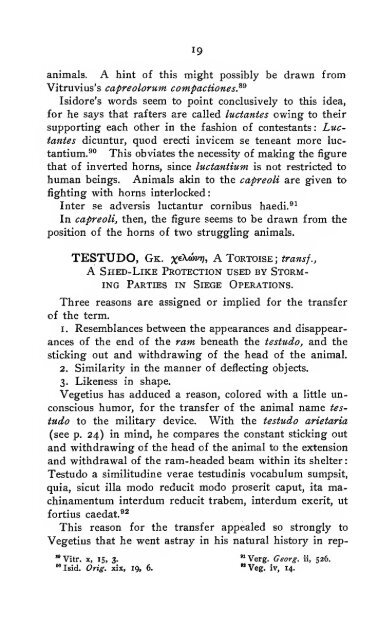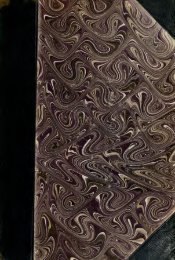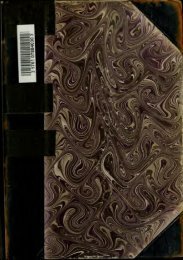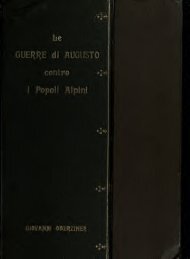Figurative uses of animal names in Latin and their ... - mura di tutti
Figurative uses of animal names in Latin and their ... - mura di tutti
Figurative uses of animal names in Latin and their ... - mura di tutti
You also want an ePaper? Increase the reach of your titles
YUMPU automatically turns print PDFs into web optimized ePapers that Google loves.
19<br />
<strong>animal</strong>s. A h<strong>in</strong>t <strong>of</strong> this might possibly be drawn from<br />
Vitruvius's capreolorum compactiones.^^<br />
Isidore's words seem to po<strong>in</strong>t conclusively to this idea,<br />
for he says that rafters are called luctantes ow<strong>in</strong>g to <strong>their</strong><br />
support<strong>in</strong>g each other <strong>in</strong> the fashion <strong>of</strong> contestants: Luc-<br />
tantes <strong>di</strong>cuntur, quod erecti <strong>in</strong>vicem se teneant more luc-<br />
tantium.®" This obviates the necessity <strong>of</strong> mak<strong>in</strong>g the figure<br />
that <strong>of</strong> <strong>in</strong>verted horns, s<strong>in</strong>ce luctantium is not restricted to<br />
human be<strong>in</strong>gs. Animals ak<strong>in</strong> to the capreoli are given to<br />
fight<strong>in</strong>g with horns <strong>in</strong>terlocked:<br />
Inter se adversis luctantur cornibus hae<strong>di</strong>.®^<br />
In capreoli, then, the figure seems to be drawn from the<br />
position <strong>of</strong> the horns <strong>of</strong> two struggl<strong>in</strong>g <strong>animal</strong>s.<br />
TESTUDO, Gk. xeXwz^, A Tortoise ; transf.,<br />
A Shed- Like Protection used by Storm<strong>in</strong>g<br />
Parties <strong>in</strong> Siege Operations.<br />
Three reasons are assigned or implied for the transfer<br />
<strong>of</strong> the term.<br />
1. Resemblances between the appearances <strong>and</strong> <strong>di</strong>sappear-<br />
ances <strong>of</strong> the end <strong>of</strong> the ram beneath the testudo, <strong>and</strong> the<br />
stick<strong>in</strong>g out <strong>and</strong> withdraw<strong>in</strong>g <strong>of</strong> the head <strong>of</strong> the <strong>animal</strong>.<br />
2. Similarity <strong>in</strong> the manner <strong>of</strong> deflect<strong>in</strong>g objects.<br />
3. Likeness <strong>in</strong> shape.<br />
Vegetius has adduced a reason, colored with a little un-<br />
conscious humor, for the transfer <strong>of</strong> the <strong>animal</strong> name tes-<br />
tudo to the military device. With the testudo arietaria<br />
(see p. 24) <strong>in</strong> m<strong>in</strong>d, he compares the constant stick<strong>in</strong>g out<br />
<strong>and</strong> withdraw<strong>in</strong>g <strong>of</strong> the head <strong>of</strong> the <strong>animal</strong> to the extension<br />
<strong>and</strong> withdrawal <strong>of</strong> the ram-headed beam with<strong>in</strong> its shelter<br />
Testudo a similitud<strong>in</strong>e verae testud<strong>in</strong>is vocabulum sumpsit,<br />
quia, sicut ilia modo reducit modo proserit caput, ita mach<strong>in</strong>amentum<br />
<strong>in</strong>terdum reducit trabem, <strong>in</strong>terdum exerit, ut<br />
fortius caedat.^^<br />
This reason for the transfer appealed so strongly to<br />
Vegetius that he went astray <strong>in</strong> his natural history <strong>in</strong> rep-<br />
"Vitr. X, 15, 3. "Verg. Georg. ii, 526.<br />
"Isid. Orig. xix, 19, 6. "Veg. iv, 14.<br />
:



![Das Kriegswesen der Alten [microform] - mura di tutti](https://img.yumpu.com/21606999/1/167x260/das-kriegswesen-der-alten-microform-mura-di-tutti.jpg?quality=85)








